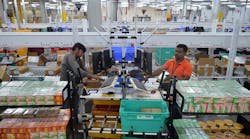Latest from Plant Operations
When gyms across the United States began to close earlier this year, retailers reported spikes as much as 625% in home equipment sales. A sudden rise in demand like this can weigh heavily on companies and manufacturers, which can result in a shortage of supplies. Here, Jonathan Wilkins, marketing director of parts supplier EU Automation, explains how the manufacturing industry can prepare for unanticipated periods of increased demand.
Several factors contribute to a product’s demand. Usually, it is determined by a person’s income and preference, the availability of substitute products and price, a seasonal period, or current circumstances. Therefore, some companies can deal with a surge in demand better than others.
Take supermarkets for example. During seasonal holidays such as Christmas, Easter, and Thanksgiving, they will see an increased demand for items such as turkey, decorations, and Easter eggs. Despite this, these are predictable events that supermarkets and manufacturers can prepare for and mitigate any shortfall in supply.
However, the disruption caused by a global pandemic is less predictable. Right now, gym equipment companies across the country are dealing with unprecedented demand. Due to the temporary closure of gyms, people are purchasing at-home exercise products and equipment, which is causing an overload of orders.
In fact, fitness gym equipment retailer Rep Fitness sold more kettlebells in one day than it would normally do in a month. Rep Fitness’s system also required a complete shakeup as a result. Due to the strain caused by such demand, operational changes were made, with the fitness retailer shifting production focus from professional gym gear to home exercise products.
Although these changes are the result of peak demand due to the unforeseen circumstances relating to COVID-19, such times emphasize the importance of planning. Ensuring supplies are always aplenty, especially when periods of unanticipated demand arise.
Inventory Management
According to retail dive, retailers worldwide lose $984 billion in sales due to unavailable items. Within that, North American businesses claim $144.9 billion of that figure. Simply put, consumers will not wait until a company restocks its shelves, meaning that stock always needs to be available.
Most manufacturers understand that inventory management is a crucial part of their success. A common method that manufacturers use to ensure they have a buffer of stock available is the safety stock approach. Although this method ensures a proportion of stock is shelved for protection against shortages in supply and rise in demand, manufacturers should not just apply these safety stock principles to finished goods only.
In fact, they should consider having a buffer of raw materials as well. By ensuring that manufacturers do not dip below the safety stock levels of raw materials, the supply chain becomes more resilient and a financial loss is prevented. This is because a bumper of raw materials helps manufacturers generate a batch of manufacturing orders in case a customer order needs to be fulfilled quickly when stock is low.
With that said, however, manufacturers need to strike the right balance with the amount of raw material stock they have. Having an excess of raw materials for a specific product can take up valuable warehouse or production floor space, and even result in increased costs.
For example, if there are complications in the supply chain, such as a hold-up on deliveries, downtime can cost manufacturers millions of dollars. Take the automotive industry, for instance, fines can be as much as $4,000 per minute for trading partners whose delivery failures cause production downtime.
Supplier Relationships
While such preventative measures help reduce financial loss by maintaining the availability of materials for production and delivery, establishing a good relationship with a supplier is also essential. Whether a manufacturer needs a supplier for raw materials or finished goods, its role is crucial as suppliers ensure the flow of goods and the stability of the supply chain.
Thankfully, parts suppliers like EU Automation, which provides new, reconditioned, and obsolete automation parts, can source the necessary materials and provide the flexibility required to respond to changes in demand. By prioritizing a company’s needs, industry experts like this ensure goods arrive on time and without delay, even during periods of unanticipated demand.
A sheer overload of orders might weigh heavily on a company’s shoulders—especially during times of unprecedented demand—but that pressure is easily lifted through the management of products and the establishment of good relationships with suppliers.














